|
Winmate 3.7" Rugged Handheld
Rugged multi-function full-VGA handheld that can run Windows CE, Linux, or even Android
(by Conrad H. Blickenstorfer with photography by Carol Cotton)
Over the last several years we've seen a massive proliferation of consumer smartphones. Initially considered expensive oddities, smartphones became mainstream when Apple released its iPhone. Hundreds of millions of smartphones later, it's become accepted that phones also need to be small computers, and they are increasingly used as computers. Large numbers are being deployed in places and for applications once reserved for dedicated handheld computers built specifically for work in the field, causing vertical market manufacturers to offer their own ruggedized versions of smartphones.
There are, however, still jobs where consumer-style smartphones, even sturdier ones, just won't do. While Apple's iOS and Google's Android have redefined user interface expectations, Windows Mobile and Windows CE have remained the software platform of choice in industrial and vertical market mobile computing. And while the world has fallen in love with the light (multi-) touch of projected capacitive touchscreens, they don't work when it gets wet, or with gloves on. And there are still jobs where slender consumer phones simply aren't up to the task. Taiwanese industrial computer manufacturer Winmate knows that, and that's why they introduced their own industrial strength and size handheld that's simply called the Winmate 3.7" Rugged Handheld Device, also listed as the R03TACH.
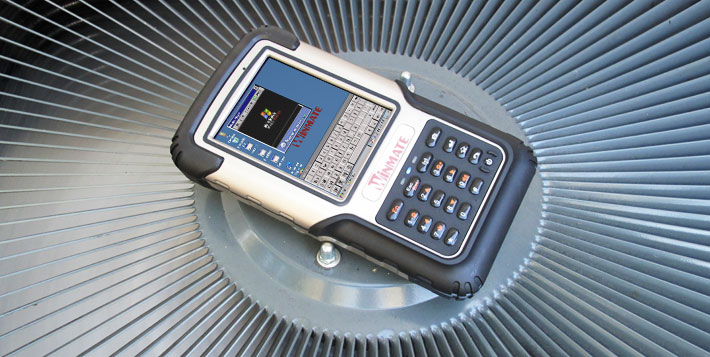
Full-size rugged handheld
In most respects, Winmate's entry into the rugged handheld computer market follows the traditional, time-proven designs that have been deployed all over the world during the past 10-15 years. The general form factor is that of a rugged, bulked-up Pocket PC or PDA, i.e. a portrait-oriented display sitting above a compact keypad.
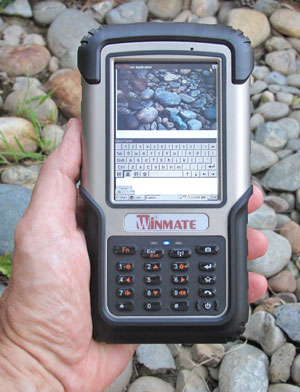 The Winmate Rugged Handheld, like similar devices in this class, is much larger and heavier than any consumer smartphone. At 7 x 3.9 inches, its foot print is almost three times that of an iPhone, and it weighs over a pound versus a consumer smartphone's featherweight four or five ounces. Instead of sleek metal and shiny glass, this handheld is made of industrial plastic and it has thick rubber bumpers to protect it from harm and scratching. The Winmate Rugged Handheld, like similar devices in this class, is much larger and heavier than any consumer smartphone. At 7 x 3.9 inches, its foot print is almost three times that of an iPhone, and it weighs over a pound versus a consumer smartphone's featherweight four or five ounces. Instead of sleek metal and shiny glass, this handheld is made of industrial plastic and it has thick rubber bumpers to protect it from harm and scratching.
In short, this Winmate handheld is neither a pretty fashion statement nor a Swiss Army knife of an entertainment device. Instead, it's simply an uncompromising tool for tough job.
This review covers the basic R03TACH-RTS1 version of the platform that also includes models with 3G WWAN communications functionality, integrated RFID reader, or integrated 1D/2D barcode reader. All versions have a bright resistive touchscreen with full-VGA 480 x 640 pixel resolution, a light sensor, and a strong 400 nit LED backlight.
Depending on the intended application, the device can be ordered with a standard number keypad or an icon-based "smart" key pad. Onboard connectivity covers all the bases with such legacy interfaces as a standard DB9 RS232 serial port, but also micro-USB, micro-SD Card, and a 3-megapixel camera with LED illuminator.
For an operating system, Winmate chose the stark but industrial-strength Windows CE 6.0 Professional r3, a software platform optimized for embedded devices with componentized architectures. And, hedging their bets, Winmate chose a TI OMAP ARM processor that can run Android as well. Add to that enough ruggedness to survive almost any abuse, and you have a handheld that can get the job done.
Design and construction
The Winmate 3.7" Rugged Handheld uses a simple, basic, form-follows-function type of design. It's meant to be held in one hand and operated with the other. The housing is made of tough plastic with a matte silver-gray finish. All corners are protected with rubber fused onto the housing and removable caps. Operation is via stylus/touchscreen and the keypad.
Below you can see the front and all four side views of the Winmate rugged handheld:
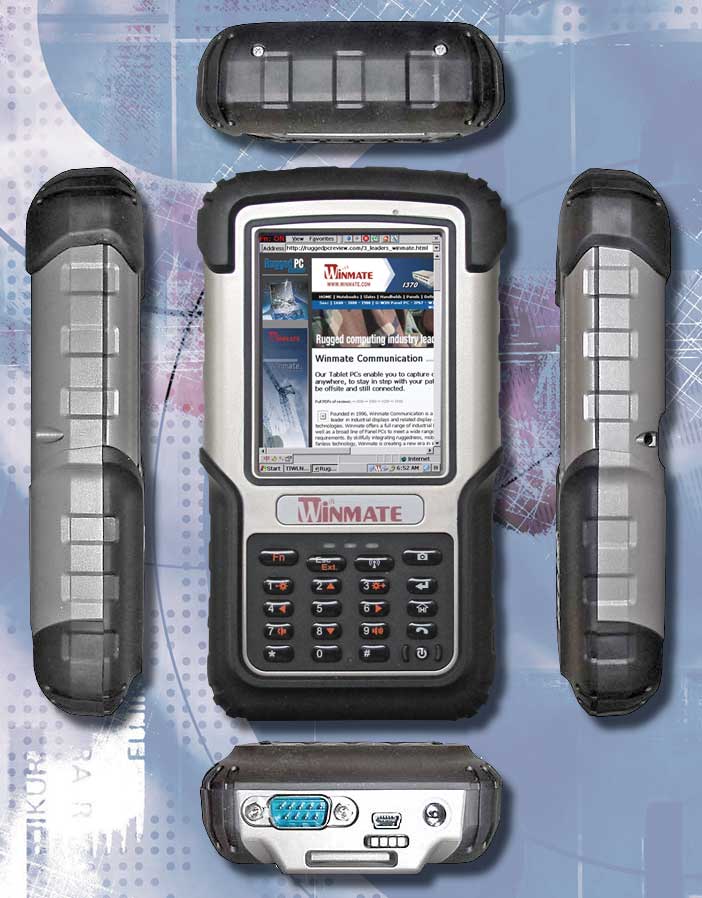
Winmate designed the R03TACH handheld with an absolute minimum of hardware controls and buttons in order to make it as simple as possible to operate under a variety of conditions. Likewise, all external connectivity is combined in one location at the bottom of the unit. Ports are as follows (from left to right):
- RS232 serial with standard DB9 connector
- Micro USB
- Docking port with surface mount contacts
- Power
Do note that this handheld is clearly designed to be used with a combination of stylus and the keypad. While it's a touch screen it's really not meant to be operated via just touch.
Below you can see the two different keypad layouts Winmate offers:

A look inside
The Winmate 3.7-inch Rugged Handheld is easy to disassemble and service. You start by undoing two screws to remove the protective plastic top cap with a tough rubber coating. Under caps such as this you often find expansion ports in rugged units.  There is no slot of opening on this unit, but there is what looks like an antenna port and also a small connector that's probably used with the optional bar code reader (see picture to the right). There is no slot of opening on this unit, but there is what looks like an antenna port and also a small connector that's probably used with the optional bar code reader (see picture to the right).
You then remove the partially rubber-coated plastic bottom boot that contains cutouts for the ports. Underneath the cap is the unit's I/O module (see below), outside of the sealed inner part of the device itself. Since the I/O module is separate from the motherboard, customization or custom configurations would appear to be easy. As is, the small I/O board has a micro-USB port, a standard 9-pin serial port, power, and docking surface mount contacts.
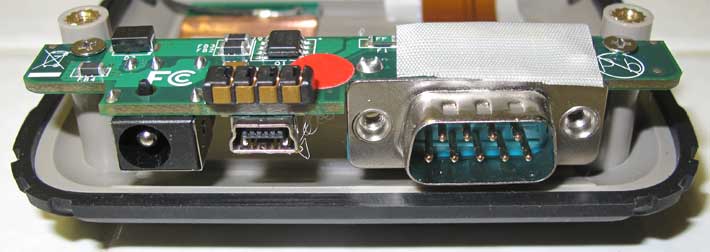
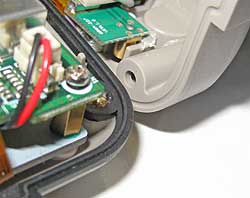 You then undo the six remaining screws and the two small nuts on the serial port and the two halves easily come apart. Now you can also see how Winmate seals the unit: the bottom plastic shell has a groove all around the unit into which fits the lip of a rubber gasket that's fused to the top half of the housing. You then undo the six remaining screws and the two small nuts on the serial port and the two halves easily come apart. Now you can also see how Winmate seals the unit: the bottom plastic shell has a groove all around the unit into which fits the lip of a rubber gasket that's fused to the top half of the housing.
That's a good technique to provide a secure tongue-and-groove seal, but it also relies on the rubber lip nicely fitting into the groove. In the picture to the right you can see the tongue-and-groove seal design.
Once opened, you can see the motherboard of the Winmate 3.7-inch Rugged Handheld, a 3.75 x 3.125 inch affair that's mounted on top of a sturdy metal plate via six spacer screws. The metal plate provides extra structural strength and may also serve as a heat spreader. The picture below shows the inside of the Winmate handheld:
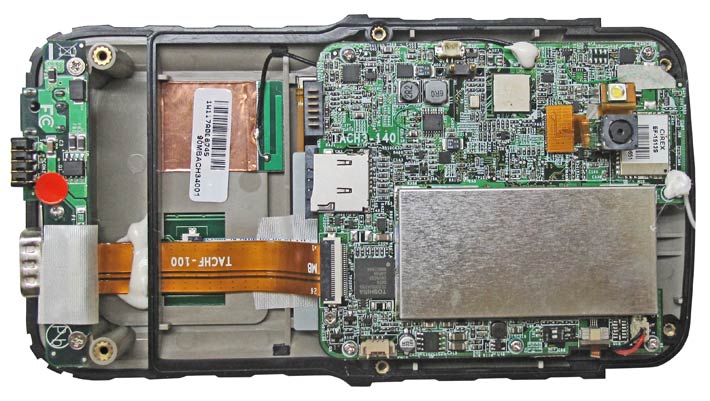
Further examination shows some of the components Winmate uses:
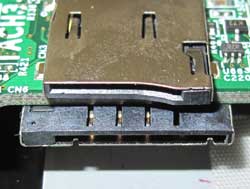 The GPS engine is a SiRFstarIII-based Cirex EF-13S, a 20-channel GPS L1 C/A code, optimized design for applications that require high sensitivity, low power and a small form factor. It supports SBAS-WAAS, EGNOS, MSAS and generally reaches accuracies of about 8-10 feet in autonomous mode, and under seven feet via SBAS (see spec sheet). The GPS engine is a SiRFstarIII-based Cirex EF-13S, a 20-channel GPS L1 C/A code, optimized design for applications that require high sensitivity, low power and a small form factor. It supports SBAS-WAAS, EGNOS, MSAS and generally reaches accuracies of about 8-10 feet in autonomous mode, and under seven feet via SBAS (see spec sheet).
WiFi and Bluetooth v.2.1 + EDR are via a multi-function JorJin WG7310-0A chipset module that supports the Cisco Client eXtensions. It is soldered right onto the motherboard (see product page).
There is a micro-SD card slot on top and a SIM card slot at the bottom of the motherboard (shown in the picture to the right), both facing into the battery compartment.
Also mounted on the motherboard is the unit's auto-focus camera and LED illuminator. It's amazing just how small those camera modules have become.
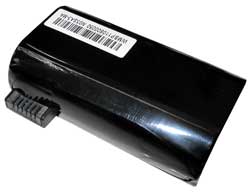 The battery (shown in the picture to the right) is a rechargeable 5,200mAH Li-Ion design that can easily be replaced in the field. Since the battery compartment contains the two card slots to the inside of the housing, there is a dense foam pressure seal between the housing and the plastic battery compartment door. The battery (shown in the picture to the right) is a rechargeable 5,200mAH Li-Ion design that can easily be replaced in the field. Since the battery compartment contains the two card slots to the inside of the housing, there is a dense foam pressure seal between the housing and the plastic battery compartment door.
The door is secured with a large flat blade screw that can be opened also with a small coin or via a small D-ring for when neither screw driver nor coins are handy.
Even though our review unit was pre-production, everything looked neat and clean inside. Winmate also secured some connectors with a white silicone glue, and also used that to seal some of the cutouts in the housing. All in all, a well executed design and nice production job.
Choice of processor
For almost a decade, we hardly ever saw a processor other than an Intel/Marvell XScale PXA chip in any Pocket PC or industrial handheld. That's slowly been changing and Winmate, too, chose to go with a competing design, in this instance a 600MHz Texas Instruments Cortex A8 OMAP 3530. That's the same chip Intermec chose for its CN70 Series of ultra-rugged computers.
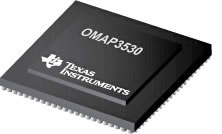 The OMAP 3530 processor is actually a dual-core system that contains both an ARM Cortex-A8 core and a C64x+ DSP, essentially a PowerVR graphics accelerator chip. That combo is quite similar to what one would find in an iPad. The chip has very good development software support by both Microsoft and Texas Instruments (see TI Cortex-A8 page). For a detailed overview and feature list of the OMAP3530, see here. The OMAP 3530 processor is actually a dual-core system that contains both an ARM Cortex-A8 core and a C64x+ DSP, essentially a PowerVR graphics accelerator chip. That combo is quite similar to what one would find in an iPad. The chip has very good development software support by both Microsoft and Texas Instruments (see TI Cortex-A8 page). For a detailed overview and feature list of the OMAP3530, see here.
Of interest to potential customers is that Winmate makes this handheld available not only with Windows CE 6.0, but also with Linux 2.6 and Android 2.2. This increases the versatility considerably. For an interesting performance comparison between Marvell, OMAP and other similar processors, check here.
Operating System
As stated above, the Winmate rugged handheld runs Windows CE 6.0, and this warrants some discussion. That's because ever since the introduction of Apple's iOS and then Android, user expectations for smartphones, tablets, and handheld computers have fundamentally changed. Before the iPhone, mobile operating systems generally looked and felt like drastically downsized versions of desktop operating systems. The iPhone showed that handheld operating systems can be sleek, fast, elegant and simple to use on displays using projected capacitive technology that allows the softest touch as well as multi-finger operation for zooming, panning, etc.
Windows CE is very different from those sleek, modern OS platforms. Initially conceived to battle the likes of the Apple Newton and the original Palm OS, Windows CE goes back some 15 years. Microsoft's little OS was never pretty and, with the sole exception of two or three years of relative popularity in Pocket PCs, never very successful in the consumer market. That's despite Microsoft putting the reasonably nice Windows Mobile interface on top of Windows CE, and despite Microsoft offering nicely integrated smartphone functionality years before the iPhone arrived.
As is, Windows CE is not a pretty operating system. Compared to iOS and Android, and even Microsoft's own Windows Phone 7, Windows CE looks crude and positively ancient. That's the bad news, and one can only wonder what caused Microsoft to keep things this basic for so many years. The good news is that after all is said and done, there's still nothing that provides full and totally reliable interoperability with existing (Microsoft) enterprise infrastructure and enables the use of the ubiquitous Microsoft development tools thousands of programmers are familiar with.

Unfortunately, Microsoft has changed the names and nomenclature of the various versions of Windows CE so many times that only the most technical experts know which version is which, and how they all differ from one another. These days, Microsoft differentiates between Windows Embedded Handheld (formerly Windows Mobile) and Windows Embedded Compact (formerly Windows CE). The latest version of the latter is Windows Embedded Compact 7, not to be confused with the rather sleek Windows Phone 7, which is a totally different development and not compatible in any way with either Windows Mobile nor Windows CE/Embedded Compact.
So why did Winmate choose Windows CE 6.0 R3? Probably because, despite its starkness, it's a powerful, scalable 32-bit OS designed for intelligent devices ranging from enterprise tools such as industrial controllers, communications hubs, and point-of-sale terminals to consumer products such as cameras, phones, and home entertainment devices. It has Silverlight for Windows embedded, can use Flash Lite, Internet Explorer, Office apps, and a vast library of utilities and application software.
Below you can see some of the basic screens of Windows CE 6.0. On the left is the blue Home screen. It usually contains nothing but the icons for a few basic functions. The picture in the center shows Internet Explorer displaying part of a page on RuggedPCReview.com. Thanks to the high resolution of the device, even small text is razor sharp. The picture on the right shows a sleek demo of an alternate shell. It demonstrates that CE 6.0 is capable of doing far more than what the stark basic user interface suggests.
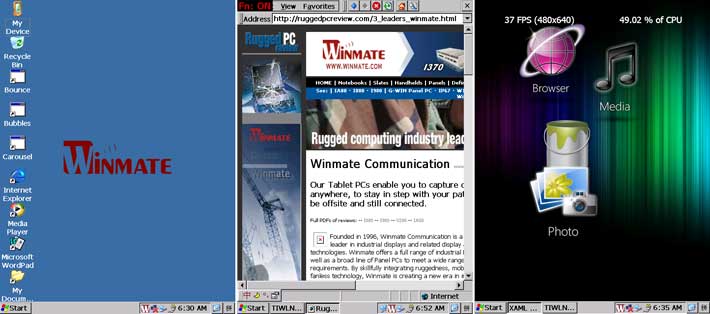
Below, from left to right is the unit's pop-up onscreen keyboard and the Windows Media Player, then typing samples, and the special symbols keyboard. Note that our test unit was pre-production without a final software complement, and with Chinese language input panels. Stateside versions will undoubtedly offer the usual variety of Western input methods.
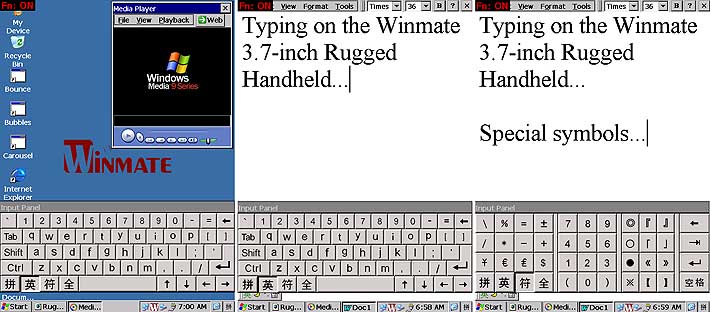
Optional configurations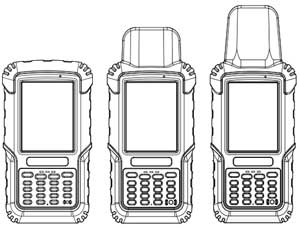
Winmate offers this device in four configurations: Standard, standard + 3G, with RFID, and with barcode reader.
While the 3G version simply adds an internal module for full HSPA/ UMTS / GPRS / WCDMA / GSM support, the RFID and barcode versions snap onto the top of the device and have different caps. The 13.56MHz RFID reader supports ANSI/ISO14443A; the barcode reader is a 2D scan module that supports a large variety of 1D and 2D codes, including QR Code, Data Matrix, PDF417, Maxicode, Aztec, etc.
The end cap expansion approach is common in this class of handhelds, but it does add a good deal of length.
Display and usability
While notebook and tablet computer displays have improved dramatically over the past several years, industrial handheld displays haven't changed very much. That's true for the Winmate's display as well. It is bright enough and it's certainly very sharp and clear, without any of the annoying iridescence we've seen on some recently released vertical market devices. And what appears to be a transflective design makes for very good viewability indoors and decent viewability outdoors. The display doesn't wash out even in strong daylight and in the sun.
What is less impressive are the display's narrow viewing angles. The horizontal viewing angle is wide enough, but the semi-matte display gets milky at wider angles. The vertical viewing angle is only marginal compared to today's smartphones that can usually be viewed from any angle. Here, even minor changes in the vertical viewing angle generate large chromatic shifts. That should not be the case.
In terms of usability, the display is fairly deeply recessed into its bezel, which makes check boxes and scrollers hard to reach even with a stylus. And while we appreciate the high 480 x 640 pixel resolution, it also means that the standard Windows CE icons, text and menus are tiny. This, of course, is only an issue when dealing with Windows CE itself. Most users will likely spend most of their time in custom applications designed for this type of display, and skillful programmers will have no problems creating complex, yet easy-to-use apps that take advantage of the high resolution and powerful hardware.
One other wish we have is for a keypad that includes alpha keys. Hundreds of millions are adept at T9 and other texting methods, and an alphanumeric keypad should be available.
Ruggedness
In terms of ruggedness, the Winmate 3.7" rugged handheld is, according to the company, "designed for all kinds of harsh environments such as offshore industry, petroleum industry and police officers." The device is definitely well built, feels rock-solid, and won't easily be scratched thanks to its rubberized protective bumpers.
As far as environmental specs go, the device is sealed to IP67 specifications, where the "6" (the highest rating) means total protection against dust, and the "7" means it is also protected against brief full immersion down to about a meter. That can happen when it's dropped into a shallow stream or ditch. In our analysis, we found the unit's sealing adequate but, as always, users must make sure that all seals are in good working order, and the top cap and battery compartment door firmly and securely locked down.
Winmate lists a very wide operating temperature of -4 to 140 degrees Fahrenheit (-20 to 60 Celsius), with the brochure even suggesting -22 degrees Fahrenheit (-30 Centigrade). That would mean the unit can be used in virtually any operating environment, including commercial freezers.
Unfortunately, the specs don't list detailed ruggedness data and only suggest that the unit is vibration, drop and tumbling resistant. More detailed data is likely available from Winmate, and it should really be part of the official published specs of a rugged device.
Bottom line: Winmate R03TACH-RTS1 3.7" Rugged Handheld Device
Overall, the Winmate 3.7" Rugged Handheld Device is a welcome addition to a market that's not sure anymore whether given tasks really need an expensive dedicated rugged device, or whether they can be done more cheaply with consumer smartphones. This Winmate handheld does not pretend, or seek to be, a more durable replacement for a smartphone. That's not what it is. Instead, it's a purpose-designed tool for jobs in the field where it gets rained on, rattled around, and occasionally dropped.
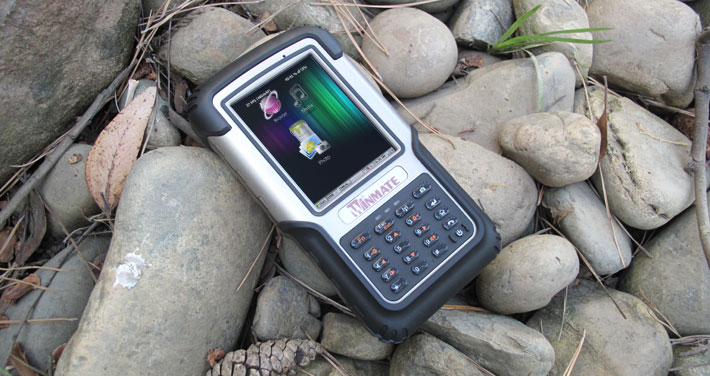
Despite its conservative looks and support of legacy hardware and software (such as including a standard DB9 serial port and running the workmanlike but practical Windows CE 6.0), the Winmate handheld is actually quite modern. Its OMAP processor can handle, and is supported by, Linux and Android in addition to Windows CE. It has an microSDHC card slot. It has GPS, a camera, and can be configured with RFID or a scanner. Its 3.7-inch display is crisp and sharp, and can easily be used in sunlight.
What all of this means is that this Winmate handheld is a computer that neatly fits into Microsoft-based IT structures, and leverages investment in Microsoft tools and resources. It looks to be very durable, it's simple to use, and though much larger than a smartphone, it's still lighter and handier than flashlight-style mobile computers. There's still ample room and application for these tools for tough jobs. If you or your company needs one, or a thousand, put this Winmate device on your short list.
-- Conrad H. Blickenstorfer, September 2011
|
Winmate 3.7" Rugged Handheld Specifications
|
| Added/changed |
Added 9/2011, specs updated 04/2013
|
| Type |
Rugged handheld computer
|
| Processor |
1GHz TI Cortex A8 OMAP DM3730 |
| OS |
Windows CE 6.0 |
| GPS |
Cirex SiRFstarIII GPS |
| RAM/ROM |
256MB/512MB NAND FLASH |
| Display |
3.7" color TFT with VGA (480 x 640 pixel) resolution (400 nits) |
| Digitizer/Pens |
Resistive touchscreen |
| Keyboard/keys |
Onscreen |
| Navigation |
Stylus/touch |
| Expansion slots |
1 micro-SD/SDHC (up to 16GB) Card slot inside battery compartment, 1 SIM card slot |
| Housing |
ABS plastic with rubberized bumper areas |
| Size |
3.9 x 7.05 x 1.5 inches (100 x 180 x 38 mm) |
| Weight |
16.9 oz. as tested with standard battery |
| Temperature |
-4 to 140 degrees Fahrenheit (-20 to 60C) |
| Ingress Protection |
IP67 (totally dust-proof, protected against immersion up to 3.3 feet) |
| Drop |
NA |
| Tumbling |
NA |
| Humidity |
95% RH (non condensing) |
| ESD |
NA |
| Regulatory |
CE, FCC class B |
| Power |
replaceable, rechargeable Li-Ion 5,000mAH ("8.8 hours") |
| Camera |
3.0mp autofocus camera with LED auxiliary light |
| Communication |
Cirex SiRFstarIII GPS, 802.11b/g/n WiFi, Bluetooth V2.1 + EDR |
| Communication |
Optional 3G Module (support HSPA/ UMTS / GPRS / WCDMA / GSM)
|
| Interface |
1 mini-USB, 1 DB9 serial RS232, power, mic/speaker |
Price |
inquire |
Web
|
S370 web page
|
Data sheet |
S370 data sheet (PDF)
|
| Contact |
Sales1@winmate.com.tw
Winmate Communication Inc.
9F, No. 111-6, Shing-De Road,
San-Chung City,
Taipei, Taiwan 241, R.O.C.
Fax: +886-2-8511-0211
Web: www.winmate.com.tw |
|
|





